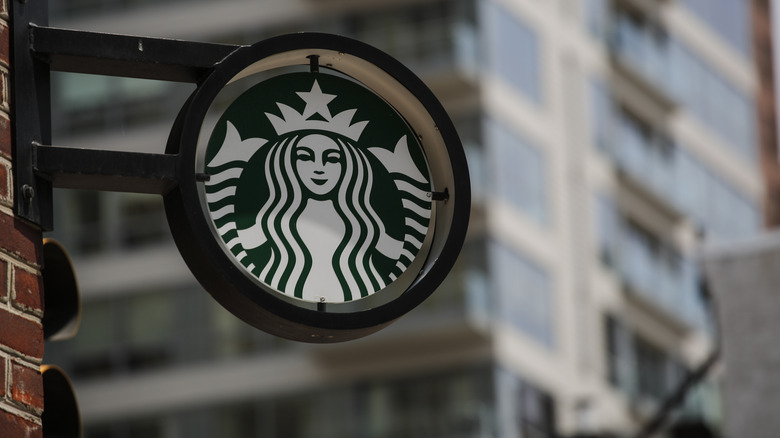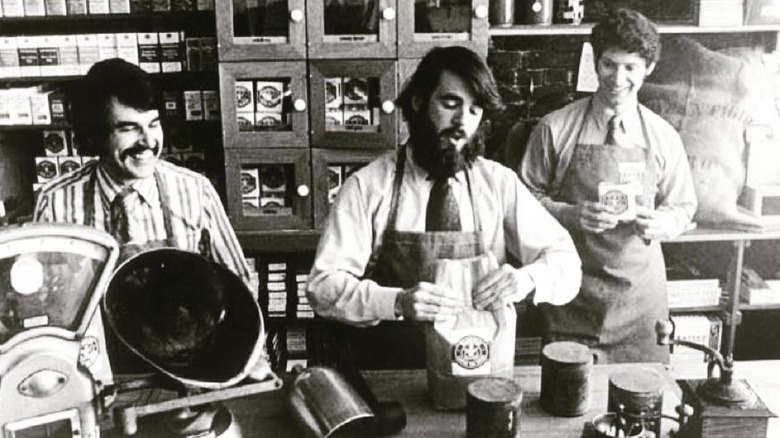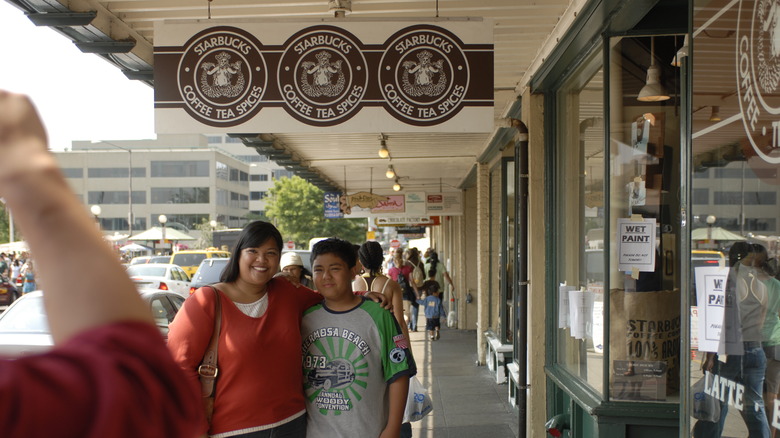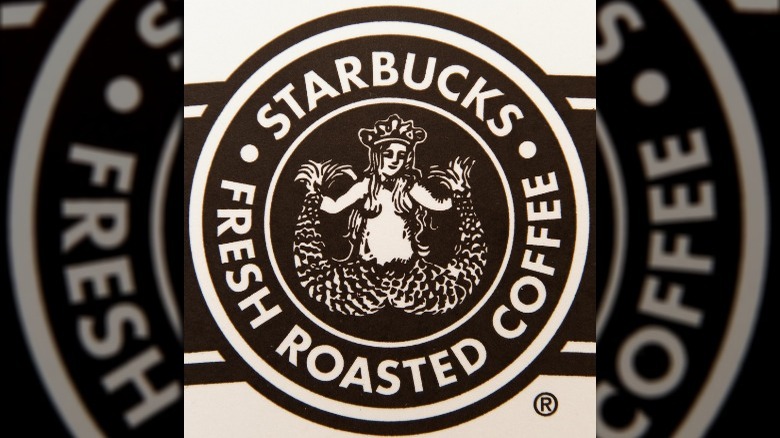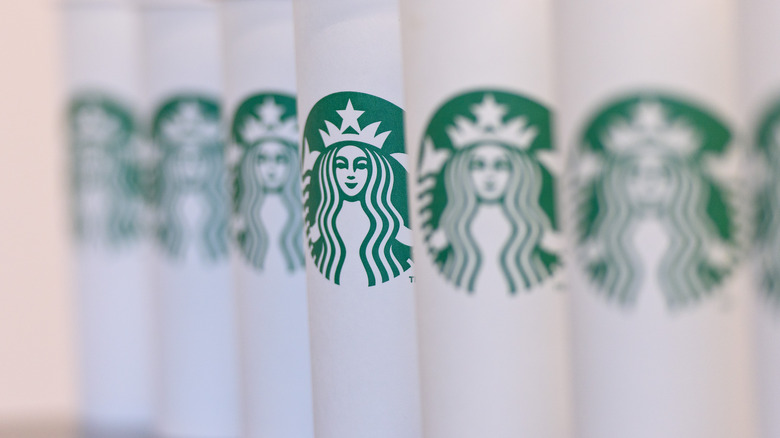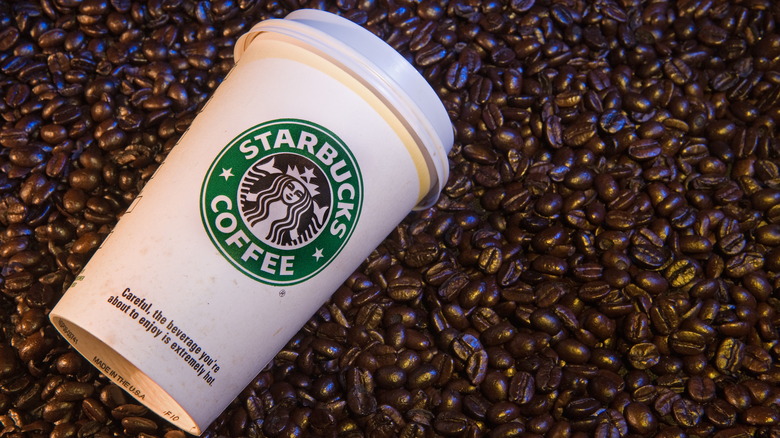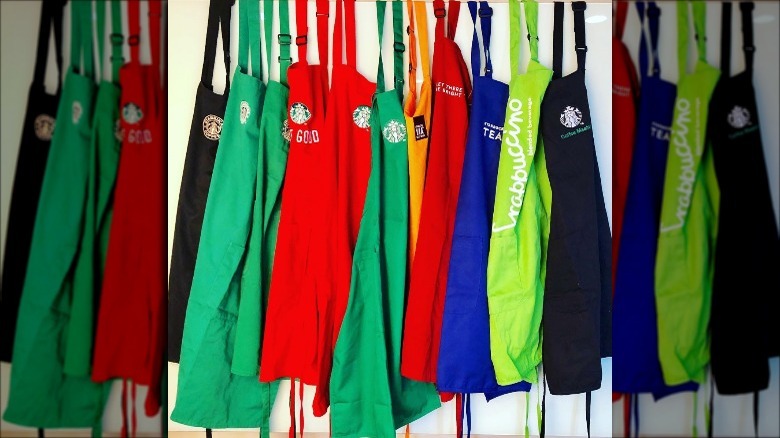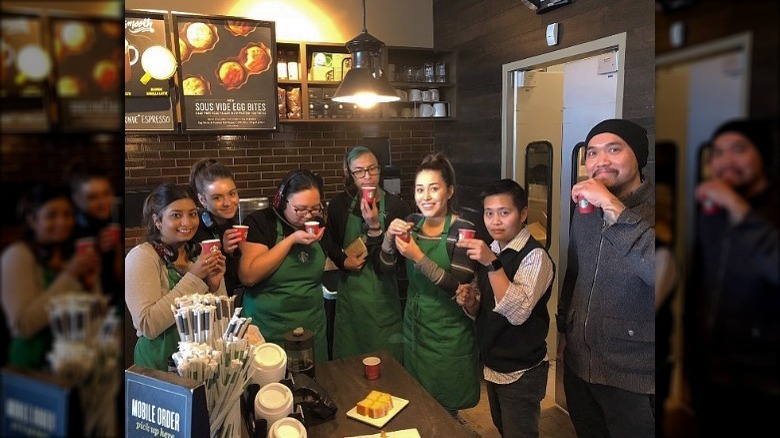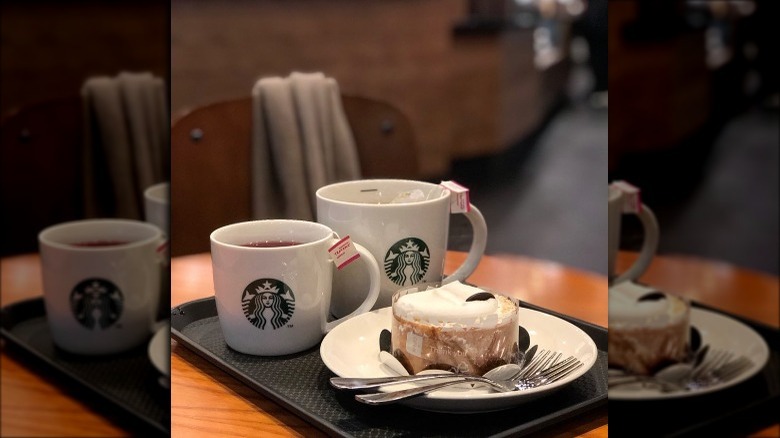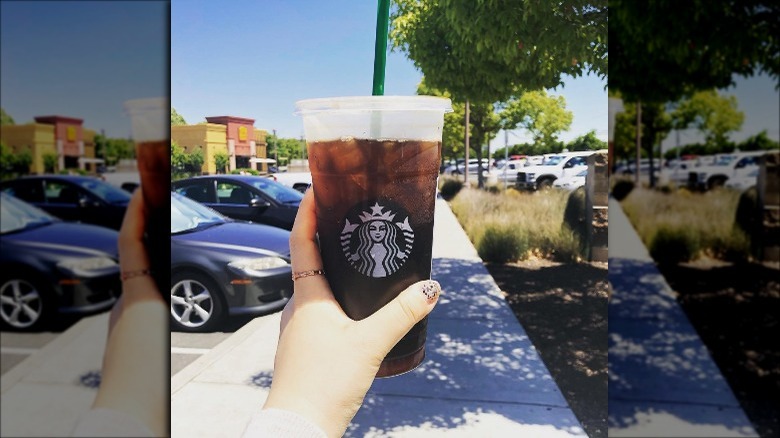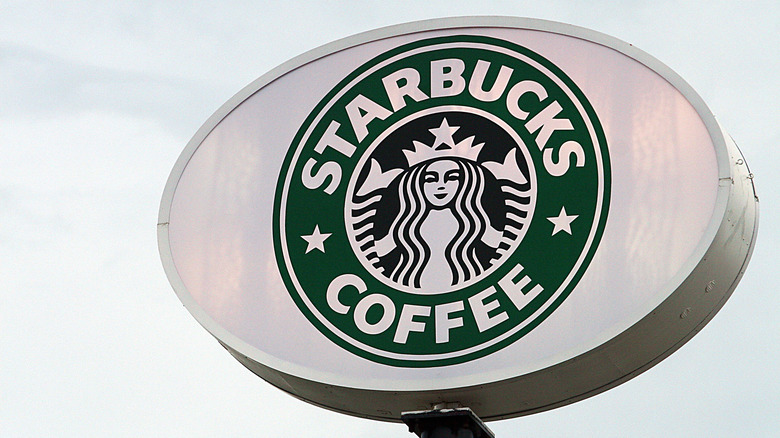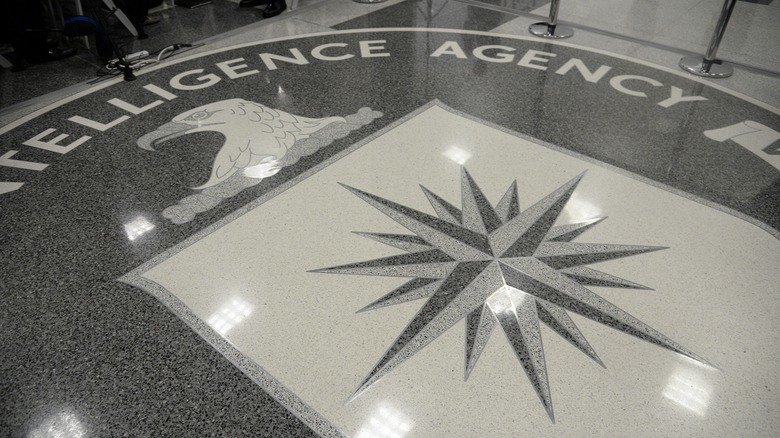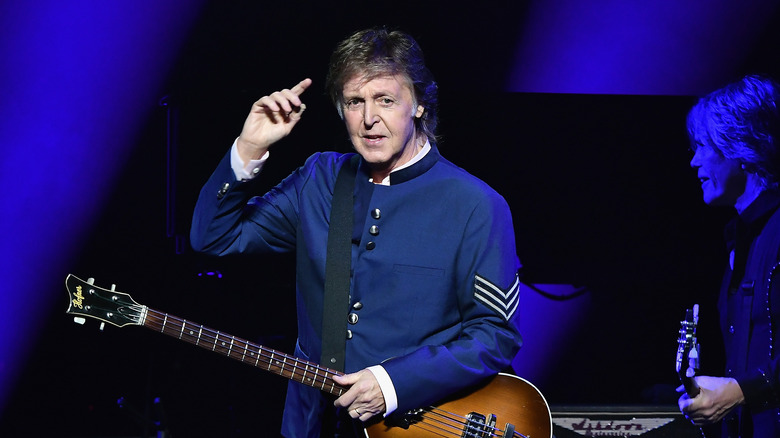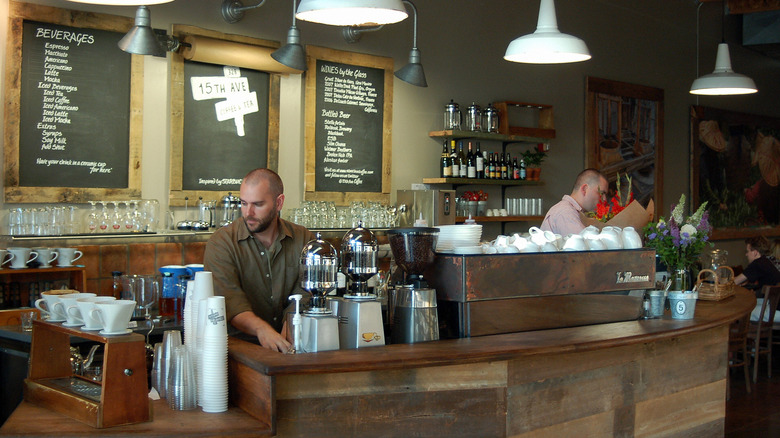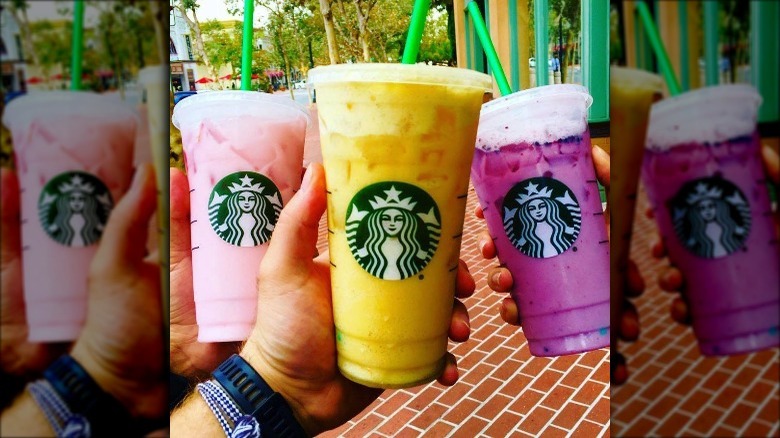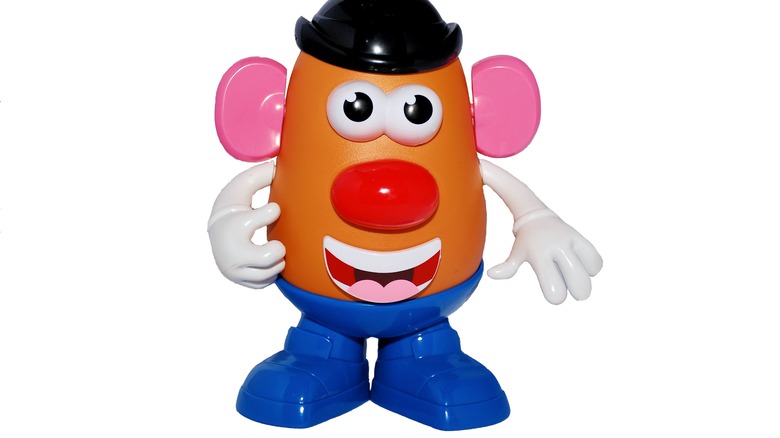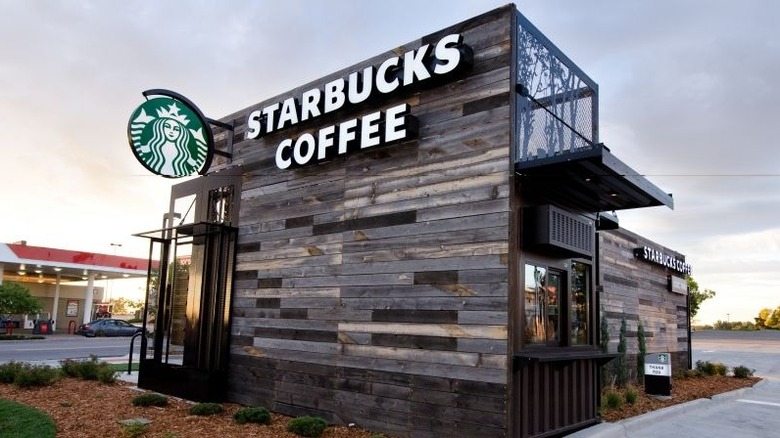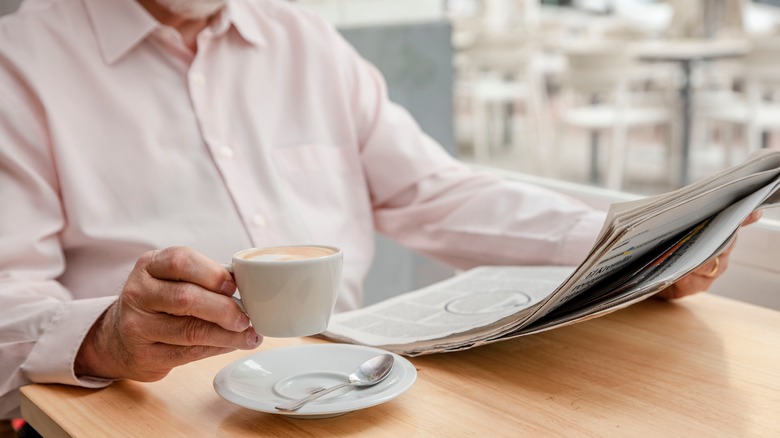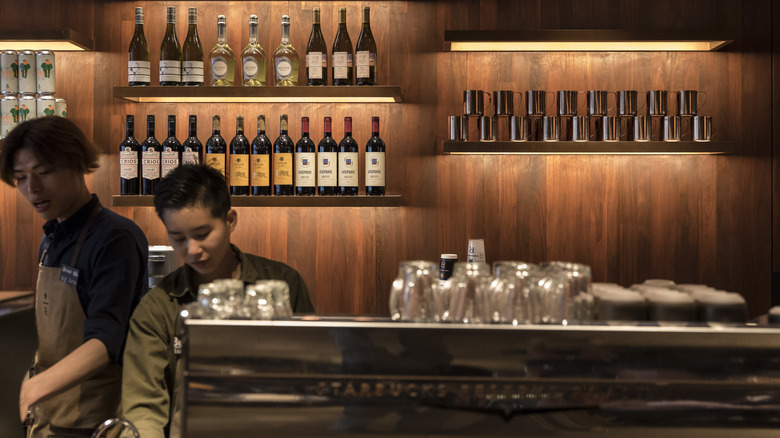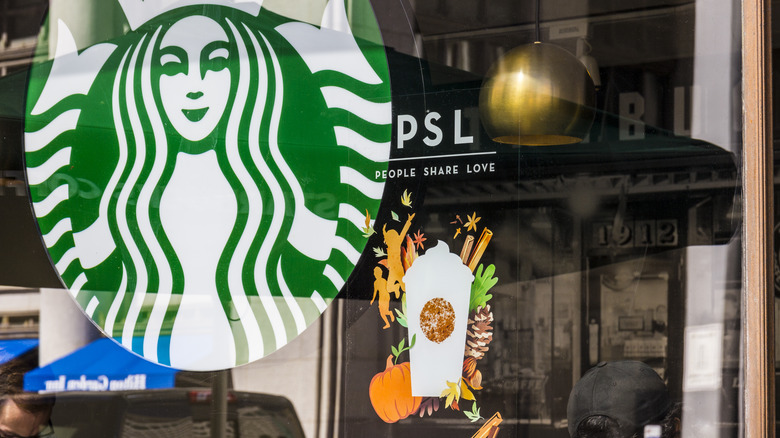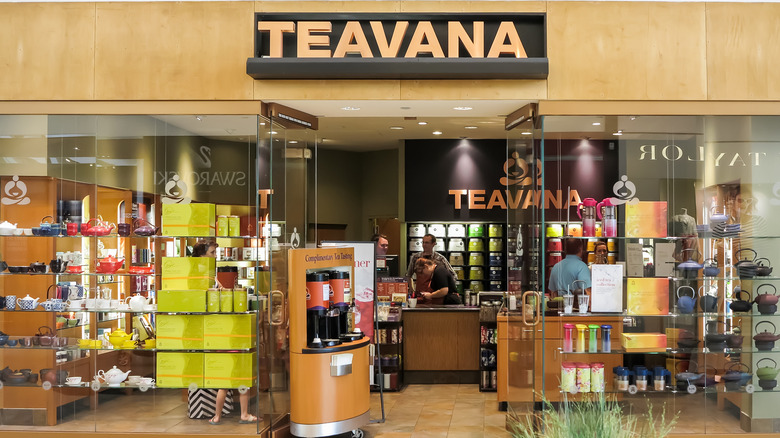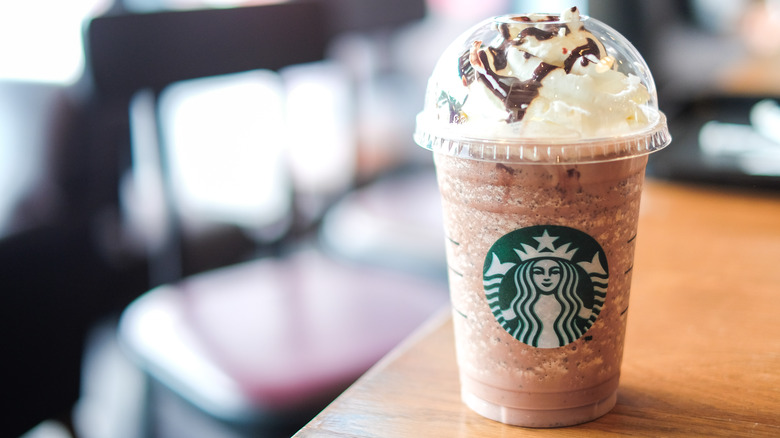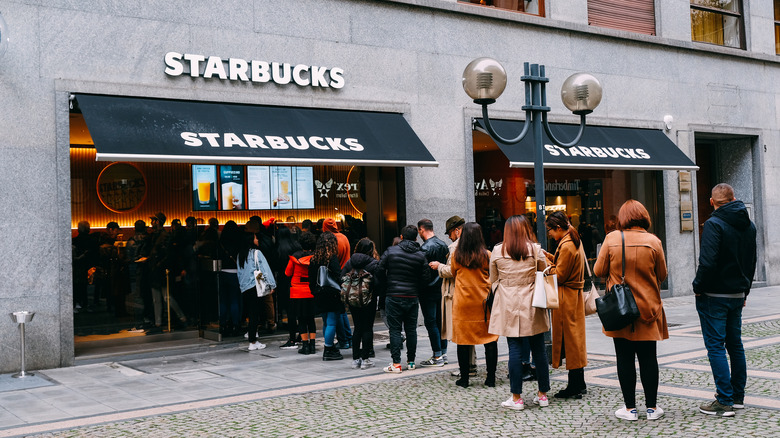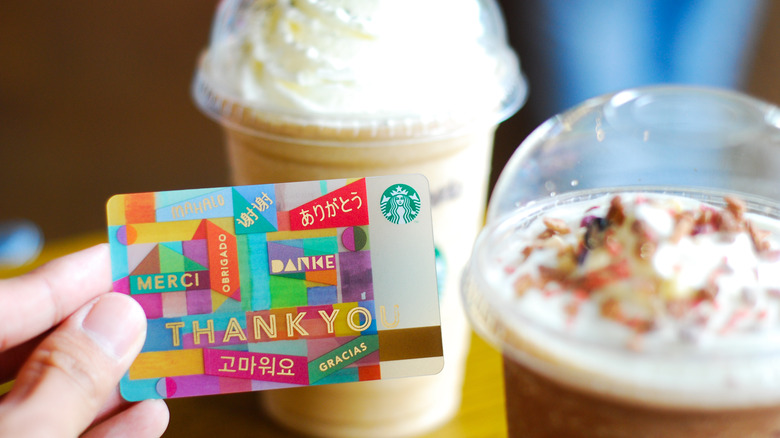The Untold Truth Of Starbucks
You know Starbucks. It's that chain of coffee stores which exists on what seems like every single street corner in the world. They've got that logo — you know the one. And then there's that smell; that unmistakable, inimitable Starbucks smell. Not many places can lay claim to having an iconic smell, but these guys have nailed it.
Ever since its foundation in 1971, Starbucks has grown from a modest Seattle coffee shop to the corporate behemoth whose defining characteristics are recognizable to people from every corner of the Earth. What may seem like a simple staple of our day-to-day lives, however, is actually a fascinatingly complex organization with a vivid history and a whole host of bizarre little quirks that many people are totally unaware of. From its racy early logo and the literary origins of its name, to their foray into the music biz, and a clandestine branch in Langley, this is the untold truth of Starbucks.
The founders
Starbucks fans have three people to thank for bringing the company into the world. The first is Gordon Bowker, a college dropout from Seattle who had discovered his love of coffee on a trip to Italy in 1962. The other two were Bowker's roommates, Jerry Baldwin and Zev Siegl. Spurred on by their love of good coffee, they began roasting their own coffee. Together, they started a company and named it Starbucks. This early iteration of the legendary coffee shop sold coffee beans, tea, spices, coffee machines and accessories. It wasn't until many years later, under a different owner, that they began to sell coffee drinks.
But Bowker, Baldwin, and Siegl wouldn't be with Starbucks forever. In the '80s, a young salesman named Howard Schultz bought out the company. Today, Bowker lives a modest life, having for a time owned Peet's Coffee & Tea (where he still serves on the Board of Directors) and Redhook Ale Brewery. Baldwin is the proprietor of his own wine company in California and served as President of the Association Scientifique Internationale du Café. Siegl is a business advisor and motivational speaker.
The first location wasn't really the first
The site of the original Starbucks is something of a place of pilgrimage for coffee fans, even today. The famous tourist spot, however, is actually the store's second location, to which it moved in 1977. Nonetheless, it constitutes a must-visit for visitors to Seattle from all around the world.
The store isn't much different to how it was back in the '70s: it's a small building, and there's nowhere to sit or hang out inside (a remnant of the company's original operation as a place to buy coffee beans and accessories, rather than drink coffee). That's not to say they haven't modernized at all, though — you can now buy coffee drinks at the original store, which actually offers everything you'd find in any other modern Starbucks branch. In fact, to a passing observer, the only thing that would really give any indication as to this store's long and hallowed history are the strange, barely-recognizable logos emblazoned around the room.
Their original logo was raunchy
The Starbucks logo is one of the most iconic in corporate history. Few can quite match the sheer recognizability of that white mermaid on her green background — the McDonald's arches, perhaps, or the Nike swoosh. Still, though, it's up there. But that wasn't quite always the Starbucks logo.
The original logo — which is still plastered all over that early Seattle branch — was actually brown, and depicted the mermaid as topless. The idea was that the two-tailed mermaid, who was based on an image found on a 16th century woodcut, was supposed to appear as seductive as the coffee itself. Naturally, complaints were made, but Starbucks didn't see a problem until they reached the point at which the logo needed to appear in large on the side of delivery trucks. The logo was therefore redesigned, the mermaid was given her modesty (plus a new hairstyle to boot) and the legendary modern icon was born.
The name had novel beginnings
Nowadays, nobody puts much thought into what the name Starbucks could possibly mean. And why should they? After all, everyone already knows what it means: it's the name of a coffee shop. Once upon a time, however, the name might have seemed a little peculiar — and that's because it finds its origins in a very specific place.
The founders of Starbucks took the name from Moby Dick, the legendary novel by Herman Melville. In the book, Starbuck is the name of the first mate of the Pequod, Captain Ahab's ship, and provides a calmer contrast to the obsessive nature of Ahab himself. Starbucks, however, was actually a second-choice name for the company. Gordon Bowker had actually wanted to call the company Pequod, but Bowker's marketing partner Terry Heckler was unconvinced. Eventually, the two settled on Starbucks as a name, presumably having ruled out 'Ahab', 'Ishmael' and 'Captain Boomer'. It's for the best, really.
They work hard for that fabulous aroma
Yep, it's that classic Starbucks aroma. In his 1997 book "Pour Your Heart Into It," Howard Schultz describes it as "heady, rich, full-bodied, dark, suggestive." Whatever it is, it's one of the defining features of Starbucks' image and pervades practically every Starbucks store across the planet.
But keeping that smell strong is hard work for the company. Coffee beans tend to absorb odors, meaning it's easy for them to be ruined by contaminant smells. To prevent this from happening, Starbucks banned smoking in their stores long before it became the law. They also prevent their employees from using perfumes and colognes, and refuse to sell chemically-flavored coffee beans. Strong-smelling goods such as soup, pastrami and other foods are also off the menu (though the store does serve a small selection of simple foods such as sandwiches and pastries that are baked off-premises). What results is one pure, simple smell: coffee. Frankly, we wouldn't have it any other way.
Those apron colors aren't just for show
The classic green staff apron is practically as recognizable to Starbucks customers as the logo itself, but it's not the only one that exists. In fact, there's a whole range of other aprons which all have their own individual meanings and purposes.
The green apron is standard, of course. Military vets have the option of wearing one embroidered with an American flag, while staff members who have graduated from the Starbucks College Achievement Plan have one embroidered with a mortarboard. Orange aprons are worn in the Netherlands to celebrate King's Day, while the purple apron is saved exclusively for each year's 26 barista champions.
The black apron, meanwhile, is worn by Coffee Masters, who have a certified knowledge in the field. Occasionally, promotional events will involve the company giving out a few special aprons to each store, such as the pale blue apron for the launch of Frappuccino Happy Hour or the red aprons you might see during the holidays.
Baristas definitely have a dress code
The apron isn't the only item on the Starbucks dress code worth a look, though. In fact, the company is actually pretty strict on how it allows employees to present themselves. Here's a run-through of the rules.
Hair must be kept looking "natural", meaning no bright colors such as purple, pink, blue or green (though this seems to vary by store). Rings are allowed, but only if they have no stones, and watches, bracelets and wristbands are forbidden for food safety reasons. The apron must be kept clean, unwrinkled and unstained, while your shirt must be solid black or white and they prefer if you tuck it in. Piercings should be small, fingernails clean,and tattoos are allowed — but they must be tasteful and can't be on your face or throat. Finally, any hats worn must have the Starbucks logo, and pants, shorts or skirts should be khaki or black.
On the no-go list: blue jeans, hoodies, t-shirts, yoga pants, cowboy boots, canvas shoes and, of course, colognes and perfumes.
The tables are round for a reason
Starbucks' round tables exist at pretty much every location the company owns, and although they may not exactly evoke the warm, inviting comfort of smaller, living-room coffee shops, they're built that way for a very good reason.
According to Karen Blumenthal, author of Grande Expectations: A Year in the Life of Starbucks' Stock (via Reader's Digest), the store's round tables are made that way to make you feel less lonely and more at home. "Round tables are more welcoming than those with square edges," she writes. "And people look less alone while seated at a round table." It just goes to show that even the most innocuous characteristics of stores like Starbucks have been thought through over and over again. And sure, maybe a cynic would suggest that Starbucks make their tables this way in the hopes of keeping people from wanting to leave their stores, thus making for money from each customer — but who are we to say?
There are some cup sizes you might not know about
You're probably well aware of Starbucks' cup sizes. You've got the Tall (12 ounces), the Grande (16 ounces) and the Venti (20 ounces). But there are some other cup sizes which, despite not appearing on the menu, are available to Starbucks customers.
The first is the Short, which was one of the two original cup sizes sold by the company. It's only 8 ounces, and constitutes the smallest drink size that Starbucks offers, despite being a fairly regular size for homemade coffee. It's only available for hot drinks, and doesn't always show up on the menu boards. Another is the Trenta, a new-ish drink size that measures in at a whopping 31 ounces. It's only available for iced drinks such as iced coffee, iced tea, lemonade and other cold drinks, and usually costs 50 cents more than the Venti size. But honestly, you probably don't need it — the human stomach can only hold around 32 ounces of liquid, and a Trenta Frappuccino (which Starbucks reportedly once sold) would contain over 1,000 calories and 100 grams of sugar.
They really are everywhere... almost
If there's one thing everyone knows about Starbucks, it's that they're everywhere. Seriously — there's a good chance you can probably see one right now, and if you can't there's probably one right around the corner. The sheer scale of Starbucks' worldwide domination was put into context by Quartz in 2014. Their mapping of the chain across the world found that Starbucks existed in 63 countries, with notable absences in Africa, Central Asia and Eastern Europe. They also found that the distribution of Starbucks in cities mirrors the shape of the cities themselves, demonstrating the sheer expanse of the stores across each.
Quartz also found that Seoul had the most Starbucks at the time, closely followed by New York, Shanghai, London and Chicago. They also found that, if you travel from Boston to NYC to Philadelphia, you'll never be more than 10 miles of a Starbucks (and you could continue down to Baltimore, Washington, Richmond and Virginia and only be more than 10 miles away twice). So, yeah. Lots of Starbucks.
There's a Stealthy Starbucks
Of all the Starbucks locations around the world, however, perhaps most curious of all is that which exists deep inside the CIA's headquarters at Langley in Virginia. Known affectionately at "Stealthy Starbucks," the baristas who work at that branch are put through a wide array of background checks and interviews before they're allowed to work there, and even after getting through all that, they're escorted by agents in and out of their work area.
Despite its clandestine nature, however, the Langley branch is one of the busiest in the USA, and serves thousands of analysts, agents, economists, engineers, geographers, and cartographers each day. Despite appearing like any other Starbucks, its purpose is to provide a humanizing environment for agency workers, many of whom work in high-pressure scenarios and don't have their smartphones to help them tune-out (they have to leave those in their cars). It also provides a setting for job interviews for current agents looking to get reassigned. And no, before you ask — nobody gives their name at the counter.
They tried to get into the music biz
In 2007, Starbucks co-founded Hear Music with Concord Music Group. Starbucks had previously found its way into the music business by selling the music of artists such as Ray Charles and Bob Dylan in stores across America. That same year, however, it made its first proper signing: Paul McCartney.
The label itself didn't go far, though. After signing a smattering of artists (including Carly Simon, whose album on the label sold poorly, resulting in a failed lawsuit against them), Starbucks turned over management of the label to the Concord Music Group."
The whole sorry saga just seemed to prove that, no matter how many headliner acts you sign, attempting to make money by selling CDs in coffee shops during the advent of the age of digital music isn't a good idea after all. Who knew?
There are secret Starbucks locations
The CIA branch might be known as "Stealthy Starbucks," but that doesn't mean it's the only secretive branch around the world. The others, however, are stealthy in a different sense. The first of these branches opened in Seattle in 2009. It was named 15th Ave Coffee & Tea, but a little disclaimer on the front door read "inspired by Starbucks." In 2011, it was converted back into a Starbucks (which it been originally, as well), and it was permanently closed in 2017.
Still, the formula must have been somewhat successful — two more camouflaged Starbucks have opened in the city. In 2012, the company opened one in New York.
The Starbucks Reserve brand is a similar scheme, attempting to provide a more upmarket experience for coffee lovers which eschews the company's logo. Both this venture into the high-end sphere and the stealthy Starbucks branches represent — depending on who you ask — either an attempt to experiment with new ideas in a relatively low-risk space, or a patronizing and cynical attempt to siphon off business from local chains and entice customers who balk at the Starbucks brand. Either way, be careful if you think you've escaped the clutches of the world's most pervasive coffee brand — they may have you already.
There isn't really a secret menu
Hate to break it to you, menu hackers, but the so-called "secret menu" at Starbucks isn't actually a thing. Sure, there are entire websites dedicated to keeping track of the latest and greatest Starbucks secret menu items, but just because you see something on the internet doesn't mean it's true — a good reminder in general, really.
Thrillist spoke to baristas about the growing trend of customers waltzing up to the counter and ordering some bizarrely-named drink, and why it can be a problem. Brandon, a barista from Michigan, explained that these websites "give the drink a special name and fail to mention that there is no actual 'secret menu.'" In other words, you can definitely order a Cotton Candy Unicorn Dust Golden Frappuccino, but your barista will likely have no idea what goes into it. Christine, a barista from Colorado, advises, "Just make sure you bring in the recipe. Because if it's off the secret menu, then we probably don't know how to make it." You know, because the secret menu doesn't really exist.
One more piece of advice? Don't be that customer who orders a super-complicated "secret" drink during the busiest times of the day. Beverages with 27 modifications are best saved for times when there's no line.
Starbucks has used Mr. Potato Head to increase speed
Businesses are always looking for ways to save a few pennies because when you're a multi-billion dollar company, a few pennies here and there add up. That's especially true when a recession hits and everyone who used to buy a $4 cup of Starbucks coffee every day is like, "Maybe I should just make lattes at home." According to The Wall Street Journal, during the late-2000s recession, Starbucks' "vice president of lean thinking," Scott Heydon, decided that baristas using their bodies in normal ways was costing the company a bunch of extra money.
To help employees understand this point, the lean team enlisted the help of a Mr. Potatohead. First, someone from corporate would scatter bits of the plastic spud around a Starbucks and ask the manager to reassemble it. Then they would discuss ways to cut the time it took to complete the task, like keeping the parts closer together and assembling them in a different order, which was just a cute way to say, "We want the machine kept in the same general place as the cups and lids."
The cost-cutting measures seemed to have helped — one store cut drive-thru time by two seconds and increased transactions by about 10%. But you can only do so much during a recession. A marginally faster drive-thru experience isn't going to convince anyone who wants to save money that they shouldn't be making lattes at home.
There are some unusual Starbucks locations
Starbucks opens new restaurants wherever it thinks it will find coffee drinkers, even if that means setting up shop in unlikely places. According to Starbucks' website, the company set up one of these locations inside a literal shipping container. Actually, four shipping containers. The Tukwila, Washington location is kind of just a way for the company to inform the world that it's thinking about sustainability — it's made out of end-of-life shipping containers and was inspired by the busy shipping port visible outside the company's headquarters in Seattle. Other similar "modular" locations are made from recycled Wyoming snow fencing and wood reclaimed from a grain mill in eastern Washington.
You don't have to worry about skipping your nonfat, no-whip mocha on your big family vacation, either. There's a Starbucks on Main Street USA in Disney's Magic Kingdom, where you can place your regular order and add a Disney-themed pastry. There's a Starbucks at Universal Studios, too, and Dollywood's DM Pantry serves Starbucks coffee.
Starbucks also has a location in a ski resort at 8,200 feet, another one 196 miles from the Arctic Circle in Fairbanks, Alaska, and one on the Royal Caribbean International cruise ship Allure of the Seas. So you can't escape Starbucks' influence no matter how far up, how far north, or how far out to sea you go.
Why Starbucks stopped selling newspapers
Like all coffee shops, Starbucks wants you to think of it as a cozy spot where you can enjoy your morning coffee, flirt with the baristas, and have a few pleasant moments before heading off into whatever horrors you usually spend the rest of your days in. And it doesn't just want you to do that sometimes; it wants to be a part of your daily routine because selling you seven cups of coffee a week is infinitely preferable to selling you an occasional cup of coffee.
In the past, one of the ways Starbucks tried to make itself more inviting to the average morning commuter was by selling newspapers, so you could sit down and read the headlines while enjoying your grande 2/3 caff 1/2 almond milk extra whip caramel macchiato. Unfortunately, not everyone seemed to understand that Starbucks was selling newspapers, not making them available for free, and in 2019 the coffee giant announced it would no longer be stocking copies of The New York Times next to racks of grab-n-go snacks — because those got axed, too (via The New York Post). The reason: Customers would come into the shop, take a newspaper off the rack without paying for it, read it, and then leave it sitting on a table so another customer could come along and do pretty much the same thing. The spokesperson who shared the news did not elaborate on whether customers were taking similar liberties with the grab-n-go snacks.
You could once enjoy wine or beer at select Starbucks locations
Starbucks equals caffeine. Starbucks shops that stay open long after sundown might save your life when you're on a long road trip, your spouse is snoring away in the passenger seat, and the road is starting to look exactly like the backs of your eyelids. But you may not realize that for a brief window of time, longer hours for some Starbucks locations represented a warp in the space-time continuum when your favorite coffee purveyor suddenly transformed itself into a ... bar. Yes, according to Starbucks, certain locations once offered a selection of carefully curated local craft beers and wines alongside their regular caffeinated menu.
The first shop to attempt to bridge the gap between cafe and pub was the Olive Way location in Seattle. Eventually, "Starbucks Evenings" menus and extended hours were available in 400 other locations. The company insisted it knew what it was doing — research made it clear that 70% of its customers were wine enthusiasts, so obviously they would want to drink their wine where they drank their coffee.
Sadly, Starbucks Evenings didn't take off as well as the company hoped it would. According to Forbes, in 2017, the company announced it was going to end the program because it was not a "table service" sort of business. However, it still sells "coffee-inspired cocktails" at its high-end Roastery locations.
Pumpkin Spice Lattes are a top seller
Let's not mince words: The PSL is a phenomenon. Since the company first introduced it in 2003, "pumpkin spice" has become a household word, and similar flavors have appeared in everything from breakfast cereals to cocktails. In just a few short decades, the PSL has gained millions of loyal fans.
The PSL was the brainchild of Peter Dukes, who told CBS News that the drink almost didn't become a thing because it seemed a little too risky compared to flavors like caramel and cinnamon. The team tested the idea by tasting slices of pumpkin pie saturated in espresso, which sounds kind of soggy and gross, but the results were promising enough that two years later, the PSL arrived on the Starbucks fall menu. By the fall of 2021, the company reported that it had sold more than 500 million pumpkin spice lattes since the drink made its debut. The PSL is Starbucks' most popular seasonal drink and the third most popular Starbucks drink overall, behind brewed coffee and the standard Caffe Latte (via Query Sprout). That's impressive, considering that those first two drinks are available year-round, and the PSL is only on the menu from roughly late August through December.
Starbucks owns several other companies
In case you were kind of thinking of Starbucks as a giant coffee monster that silently gobbles up small businesses, leaving paper cups and pastry bags in its wake, well, you're not entirely wrong. According to Investopedia, Starbucks has "enhanced its menu offerings" over the years by buying up fruit juice and bottled water companies, other coffee and tea chains, and even a bakery chain. Instead of just taking over and operating these new acquisitions business-as-usual, the company usually shuts them down and assimilates their products, like the Borg, only with better customer service.
Sometimes, Starbucks isn't exactly straightforward about what it plans to do with its acquisitions. For example, when it bought out the famous San Francisco bakery chain La Boulange, it said it planned to expand the chain into 400 different nationwide locations. Instead, it just closed them all — the same basic story with the chain tea shop Teavana. After Starbucks bought them, it spent five years expanding the chain into additional retail locations, then it did a 180 and shut them all down. You can still buy Teavana products at Starbucks, though. Likewise, Evolution Fresh, the fruit juice chain that Starbucks shut down in 2017.
An exception is Seattle's Best Coffee — the company bought them as a way to fight back against Dunkin' Donuts and McDonald's, who dared to breach the espresso market with lower-priced offerings. Seattle's Best was Starbucks' way of competing without having to lower its prices.
There's a lot of caffeine and sugar in their drinks
Starbucks coffees are popular because, well, they taste good. And as every junk food-loving American knows, things tend to taste better when they have sugar in them.
Now, not everyone wants to have all that sugar in their diet, and at one point, Starbucks even acknowledged this point by offering "skinny" versions of their most popular drinks. But alas, the coffee giant discontinued many of their skinny syrups, not because people don't want less sugar in their drinks but because many people have no idea how much sugar is actually in those drinks. It's just a cup of coffee, right? CBS News recently reported that some Starbucks drinks are higher in sugar than a typical can of non-diet soda. For example, a venti white chocolate mocha with whipped cream has a whopping 73.8 grams of sugar. Granted, that's the biggest white chocolate mocha you can order; a tall no-whip white chocolate mocha with one pump of syrup instead of two will provide considerably less.
Now, what about caffeine? If you're worried about how jittery your morning coffee might make you, Starbucks says that the same venti white chocolate mocha contains about 150 mg of caffeine. According to Healthline, a 12-oz can of coke contains roughly 32 mg of caffeine, so drinking a venti white chocolate mocha is about the equivalent of drinking five cans of coke. Of course, for some people, that's a selling point, so whatever.
There are more Starbucks locations than you realize
If you can't remember the last time you were in a town without a Starbucks, well, you are not alone. The chain has been slowly infiltrating cities, towns, and campgrounds for thousands of years (actually just 50-something, but who's counting?), and it's even made inroads in formerly Starbucks-hostile territories like Italy. There's even a Starbucks down the street from the Vatican, which means the Italians really did lose that battle.
As of 2022, Starbucks has more than 34,000 locations worldwide (via Business Insider). That includes 17,000 locations in the United States and the 1,200 new locations it opened in 2021 alone. In 2022, Starbucks plans to add another 2,000 stores. A lot of the chain's growth has occurred outside of the United States. In fact, 1,200 of the new stores the chain opened in 2020 and 2021 were in China, and Starbucks China CEO Leo Tsoi says the chain's growth in that market is still "in the early stages."
In case you suspect there might be more Starbucks than Mcdonald's, you're not quite right. As of 2022, Mcdonald's was still in the lead, with 38,000 locations worldwide. McDonalds' growth is much slower though (in 2021 it opened only 650 new locations), so don't be surprised if it only takes a couple more years for Starbucks to overtake the fast-food giant.
How often do loyal customers visit Starbucks?
If you stop by Starbucks every morning on your way to work and you order the same tall, non-fat, no-whip mocha, your average annual Starbucks bill will be just over $1,000 (depending somewhat on where you live and whether or not you take a couple of weeks off of work every year). That's basically two days at Disneyland for four people, so you know, maybe you ought to re-evaluate your Starbucks habit.
You're not alone, though. According to Forbes, Starbucks' loyalty program has close to 20 million members, and the company says about 40% of its sales come from loyalty program members (via Digital Initiative). About two-thirds of Starbucks' customers also use the Starbucks app to order and pay (via Numerator), and 71% of app users grab a Starbucks at least once a week (compared to about 31% of those who aren't using the app). Here's where the numbers are even more astonishing — app users are also 2.3 times more likely to get a Starbucks more than once a week, 5.6 times more likely to get a Starbucks once a day, and 10.1 times more likely to move into Starbucks and pay rent (just kidding, the people in that last group go to Starbucks multiple times a day, but stop short of actually living there). That says an awful lot about actual loyalty, not just the kind of loyalty that gets you an occasional free drink.
Just how many drink options are there?
Suppose you've ever stood in line behind the lady ordering the extra hot half-caff venti no foam latte with half whole milk, half almond milk, and three pumps of cinnamon dolce. In that case, you won't be surprised to hear that Starbucks offers more than 87,000 possible drink combinations. According to a Starbucks spokesperson, you can arrive at this number by taking all Starbucks' main menu options and multiplying them by all the customization options (via The Wall Street Journal).
It's amusing, as long as everyone isn't ordering miles-long drinks. But for baristas, well, Business Insider says a lot of them have had it with the long drink orders that some customers seem to be asking for only so they can brag about it on TikTok or Instagram. Sometimes there are even so many customizations that they don't fit into one cup, and some of the customizations are just downright barf-worthy, like "add blended egg bites." Ew.
Unsurprisingly, baristas say those complicated drink orders slow down service. Equally unsurprisingly, the customers who tend to order these kinds of drinks also tend to be the ones who get testy if they aren't perfectly executed. The company doesn't plan to address any of this by limiting customizations, though, pointing out that 75% of custom orders have just one or two modifications. Of course, that does also mean that one out of four customized drinks is borderline ridiculous, but let's just focus on the positive, right?
